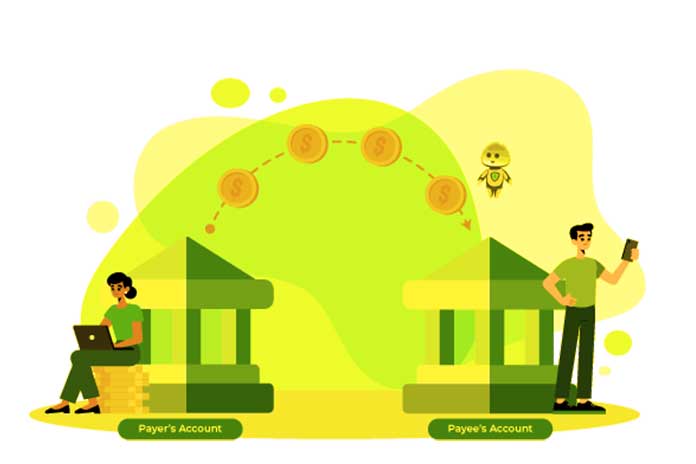From Paycheck to Bank Account – Understanding the Direct Deposit Process

Introduction
In today’s digitized world, the traditional methods of handling finances are rapidly being replaced by more secure, efficient, and convenient systems. One such system that has gained immense popularity is direct deposit. Direct deposit reduces the need for paper checks by electronically moving money from the payer’s account straight to the recipient’s bank account, saving time and money. The complexities of the direct deposit procedure and its many advantages will be examined in this essay. Direct deposit has become a vital component of contemporary financial administration, from improving ease to simplifying corporate procedures.
What is a Direct Deposit?
Direct deposit is a financial transaction method that allows automated payments from one bank account to another. It is often used for payroll and provides a seamless process from paycheck issuance to account deposit. Understanding how direct deposit works is crucial for businesses and individuals aiming for efficient financial management. This method consists of several simple steps: employers initiate the transaction and transfer funds electronically to the employee’s account using the employee’s bank account details. This automated process ensures funds are available immediately upon deposit, eliminating any waiting period.
Benefits of Direct Deposit
Convenience and Efficiency
Direct deposit revolutionizes payment processing by increasing the speed and reliability of fund transfers. Employees enjoy immediate access to their funds on payday without waiting for a check to clear. This convenience ensures that financial obligations are met promptly, reducing stress and enhancing financial mobility. For businesses, direct deposit reduces the paperwork and administrative labor involved in cutting and distributing checks, freeing up resources that can be redirected toward more productive activities.
Security and Reliability
The adoption of direct deposit greatly enhances transaction security. Unlike physical checks, which are prone to theft, loss, and fraud, electronic transactions are encrypted and regulated by stringent security protocols. This electronic method minimizes the risks associated with incorrect amounts or routing numbers, decreasing the chances of financial discrepancies. Thanks to automated verification procedures, employers and workers can feel secure knowing that their financial transactions are reliable and safe,
Environmental Impact
An often-overlooked benefit of direct deposit is its positive environmental impact. Direct deposit significantly reduces paper waste by reducing reliance on paper checks and conserving natural resources. Electronic fund transfers lessen the carbon footprint typically associated with printing and transporting physical checks. Businesses adopting eco-friendly practices through direct deposit contribute to environmental sustainability and position themselves favorably amongst environmentally conscious consumers.
How to Set Up Direct Deposit
Steps for Employers
The transition to direct deposit begins with establishing the necessary processes and ensuring that technology and personnel are in place for smooth implementation. Here are the essential steps:
- Collect Employee Information: Gather necessary banking information from employees, including bank account numbers, routing information, and signed consent forms authorizing direct deposits.
- Choose a Payroll Service Provider: Select a reliable payroll service that offers direct deposit capabilities, ensuring compatibility with existing business financial systems.
- Implement a Trial Run: Conduct a trial period to identify potential issues. This phase helps validate account details and confirm successful integration with the banking institution.
- Communicate & Educate: Keep employees informed about the direct deposit process, address potential concerns, and emphasize the benefits and reliability of this payment method.
Steps for Employees
For employees, setting up direct deposit is straightforward, typically requiring the following steps:
- Provide Banking Information: Fill out the direct deposit form provided by the employer, supplying accurate details of the bank account where funds should be deposited.
- Verify Deposits: After submission, monitor your account for test deposits during the trial phase to confirm that deposits are being successfully received.
- Maintain Up-to-date Information: Report any changes in banking information to your employer immediately to ensure uninterrupted fund transfers.
Common Mistakes and How to Avoid Them
Incorrect Data Entry
One of the most common errors in the direct deposit setup is incorrect data entry. Providing wrong banking information, such as an erroneous account number or routing number, can lead to funds being transferred to the wrong account. Double-checking information and conducting test deposits can mitigate these risks and ensure correctness.
Lack of Communication
Effective communication between employers and employees is vital for a smooth direct deposit implementation. Employers should offer clear instructions and support during this transition, while employees must promptly report any discrepancies. Open lines of communication foster trust and reduce the likelihood of errors disrupting the payroll process.
Direct Deposit and Financial Planning
Direct deposit can be an essential tool in financial planning and management. With immediate and predictable income deposits, individuals can better manage their budgets, allowing automatic allocations to savings or investment accounts. This predictability helps build saving habits and achieve financial goals, making direct deposit not just a payroll solution but also a personal financial strategy enhancer.
The Future of Direct Deposit
As technology advances, direct deposit continues to evolve, incorporating new features and integrations with digital banking tools. Automating payroll and banking processes promises even greater efficiency, reducing administrative overheads and enhancing the user experience. Future trends may include more sophisticated features like smart fund allocation and integration with digital financial advisors to provide personalized financial insights. By embracing these advances, businesses can continue to benefit from increasing efficiencies while providing improved financial services to their employees.
Conclusion
Direct deposit is a testament to digital transformation’s power in financial management. It streamlines transferring funds from paycheck to bank account, offering unmatched efficiency, security, and environmental benefits. By eliminating the complexities and risks associated with physical checks, direct deposit becomes a win-win solution for employers and employees. As technology and financial systems evolve, direct deposit is poised to play an increasingly prominent role in shaping the future of financial transactions, personal finance, and business operations. Embracing this process means embracing a future where financial difficulties are minimized, and opportunities for efficient money management are maximized.
Also Read: Mobile Banking vs. Traditional Banking
